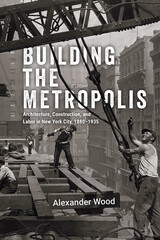7 books about Farley, Reynolds
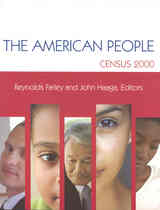
The American People
Census 2000
Reynolds Farley
Russell Sage Foundation, 2005
For more than 200 years, America has turned to the decennial census to answer questions about itself. More than a mere head count, the census is the authoritative source of information on where people live, the types of families they establish, how they identify themselves, the jobs they hold, and much more. The latest census, taken at the cusp of the new millennium, gathered more information than ever before about Americans and their lifestyles. The American People, edited by respected demographers Reynolds Farley and John Haaga, provides a snapshot of those findings that is at once analytically rich and accessible to readers at all levels. The American People addresses important questions about national life that census data are uniquely able to answer. Mary Elizabeth Hughes and Angela O'Rand compare the educational attainment, economic achievement, and family arrangements of the baby boom cohort with those of preceding generations. David Cotter, Joan Hermsen, and Reeve Vanneman find that, unlike progress made in previous decades, the 1990s were a time of stability—and possibly even retrenchment—with regard to gender equality. Sonya Tafoya, Hans Johnson, and Laura Hill examine a new development for the census in 2000: the decision to allow people to identify themselves by more than one race. They discuss how people form multiracial identities and dissect the racial and ethnic composition of the roughly seven million Americans who chose more than one racial classification. Former Census Bureau director Kenneth Prewitt discusses the importance of the census to democratic fairness and government efficiency, and notes how the high stakes accompanying the census count (especially the allocation of Congressional seats and federal funds) have made the census a lightening rod for criticism from politicians. The census has come a long way since 1790, when U.S. Marshals setout on horseback to count the population. Today, it holds a wealth of information about who we are, where we live, what we do, and how much we have changed. The American People provides a rich, detailed examination of the trends that shape our lives and paints a comprehensive portrait of the country we live in today. A Volume in the Russell Sage Foundation Census Series
[more]

Blacks and Whites
Narrowing the Gap?
Reynolds Farley
Harvard University Press
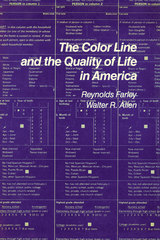
The Color Line and the Quality of Life in America
Reynolds Farley
Russell Sage Foundation, 1987
Is the United States a nation divided by the "color line," as W.E.B. Dubois declared? What is the impact of race on the lives of Americans today? In this powerful new assessment of the social reality of race, Reynolds Farley and Walter Allen compare demographic, social, and economic characteristics of blacks and whites to discover how and to what extent racial identity influences opportunities and outcomes in our society. They conclude that despite areas of considerable gain, black Americans continue to be substantially disadvantaged relative to whites. A Volume in the Russell Sage Foundation Census Series
[more]
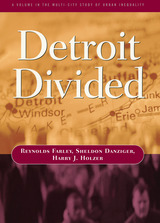
Detroit Divided
Reynolds Farley
Russell Sage Foundation, 2000
Unskilled workers once flocked to Detroit, attracted by manufacturing jobs paying union wages, but the passing of Detroit's manufacturing heyday has left many of those workers stranded. Manufacturing continues to employ high-skilled workers, and new work can be found in suburban service jobs, but the urban plants that used to employ legions of unskilled men are a thing of the past. The authors explain why white auto workers adjusted to these new conditions more easily than blacks. Taking advantage of better access to education and suburban home loans, white men migrated into skilled jobs on the city's outskirts, while blacks faced the twin barriers of higher skill demands and hostile suburban neighborhoods. Some blacks have prospered despite this racial divide: a black elite has emerged, and the shift in the city toward municipal and service jobs has allowed black women to approach parity of earnings with white women. But Detroit remains polarized racially, economically, and geographically to a degree seen in few other American cities. A Volume in the Multi-City Study of Urban Inequality
[more]
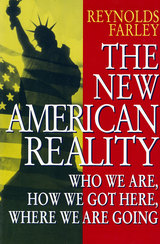
The New American Reality
Who We Are, How We Got Here, Where We Are Going
Reynolds Farley
Russell Sage Foundation, 1996
"A fascinating and authoritative account of American social history since 1960 as viewed through the prism of government statistics....[Farley] uses publicly available data, straight forward methods, and modest...language, to provide more information and insight about recent social trends than any other volume in print." —American Journal of Sociology "A brilliant piece of work. Farley is absolutely masterful at taking tens of thousands of national survey statistics and weaving from them a fascinating and beautifully illustrated tapestry of who we are." —Barry Bluestone, Frank L. Boyden Professor of Political Economy, University of Massachusetts, Boston The New American Reality presents a compelling portrait of an America strikingly different from what it was just forty years ago.Gone is the idealized vision of a two-parent, father-supported Ozzie and Harriet society. In its place is an America of varied races andethnic backgrounds, where families take on many forms and mothers frequently work outside the home. Drawing on a definitive analysis of the past four U.S. censuses, author Reynolds Farley reveals a country that offers new opportunities for a broader spectrum of people, while at the same time generating frustration and apprehension for many who once thought their futures secure. The trends that have so transformed the nation were kindled in the 1960s, a watershed period during which many Americans redefined their attitudes toward the rights of women and blacks. The New American Reality describes the activism, federal policymaking, and legal victories that eliminated overtracial and sexual discrimination. But along with open doors came new challenges. Divorce and out-of-wedlock births grew commonplace, forcing more women to raise children alone and—despite improved wages—increasing their chances of falling into poverty. Residential segregation, inadequate schooling, and a particularly high ratio of female-headed families severely impaired the economic progress of African Americans, many of whom were left behind in declining central cities as businesses migrated to suburbs. A new generation of immigrants from many nations joined the ranks of those working to support families and improve their prospects, and rapidly transformed the nation's ethnic composition. In the 1970s, unprecedented economic restructuring on a global scale created unexpected setbacks for the middle class. The long era of postwar prosperity ended as the nation's dominant industry shifted from manufacturing to services, competition from foreign producers increased, interest rates rose, and a new emphasis on technology and cost-cutting created a demand for more sophisticated skills in the workplace. The economic recovery of the 1980s generated greater prosperity for the well-educated and highly skilled, and created many low paying jobs, but offered little to remedy the stagnant and declining wages of the middle class. Income inequalitybecame a defining feature in the economic life of America: overall, the rich got richer while the poor and middle class found it increasingly difficult to meet their financial demands. The New American Reality reports some good news about America. Our lives are longer and healthier, the elderly are much better off than ever before, consumer spending power has increased, and minorities and women have many more opportunities. But this book does not shy away from the significant problems facing large portions of the population, and provides a valuable perspective on efforts to remedy them. The New American Reality offers the information necessary to understandthe critical trends affecting America today, from how we earn a living to how and when we form families, where we live, and whether or not we will continue to prosper. A Volume in the Russell Sage Founadtion Census Series
[more]
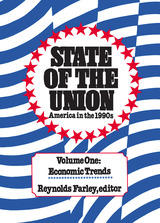
State of the Union
America in the 1990s, Economic Trends
Reynolds Farley
Russell Sage Foundation, 1995
"The Census is a most valuable source of information about our lives; these volumes make the story it has to tell accessible to all who want to know." —Lee Rainwater, Center for Advanced Study in the Behavioral Sciences "A lucid and balanced overview of major trends in the United States and essential reading for policymakers. State of the Union is a reality check that provides the factual basis for policy analysis."—Peter Gottschalk, Boston College State of the Union: America in the 1990s is the definitive new installment to the United States Census Series, carrying forward a tradition of census-based reports on American society that began with the 1930 Census. These two volumes offer a systematic, authoritative, and concise interpretation of what the 1990 Census reveals about the American people today. •Volume One: Economic Trends focuses on the schism between the wealthy and the poor that intensified in the 1980s as wages went up for highly educated persons but fell for those with less than a college degree. This gap was reflected geographically, as industries continued their migration from crumbling inner cities to booming edge cities, often leaving behind an impoverished minority population. Young male workers lost ground in the 1980s, but women made substantial strides, dramatically reducing the gender gap in earnings. The amount of family income devoted to housing rose over the decade, but while housing quality improved for wealthy, older Americans, it declined for younger, poorer families. •Volume Two: Social Trends examines the striking changes in American families and the rapid shifts in our racial and ethnic composition. Americans are marrying much later and divorcing more often, and increasing numbers of unmarried women are giving birth. These shifts have placed a growing proportion of children at risk of poverty. In glaring contrast, the elderly were the only group to make gains in the 1980s, and are now healthier and more prosperous than ever before. The concentrated immigration of Asians and Latinos to a few states and cities created extraordinary pockets of diversity within the population. Throughout the 1990s, the nation will debate questions about the state of the nation and the policies that should be adopted to address changing conditions. Will continued technological change lead to even more economic polarization? Will education become an increasingly important factor in determining earnings potential? Did new immigrants stimulate the economy or take jobs away from American-born workers? Will we be able to support the rapidly growing population of older retirees? State of the Union will help us to answer these questions and better understand how well the nation is adapting to the pervasive social and economic transformations of our era. A Volume in the Russell Sage Foundation Census Series
[more]
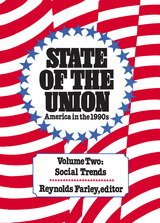
State of the Union
America in the 1990s, Social Trends
Reynolds Farley
Russell Sage Foundation, 1995
"The Census is a most valuable source of information about our lives; these volumes make the story it has to tell accessible to all who want to know." —Lee Rainwater, Center for Advanced Study in the Behavioral Sciences "A lucid and balanced overview of major trends in the United States and essential reading for policymakers. State of the Union is a reality check that provides the factual basis for policy analysis."—Peter Gottschalk, Boston College State of the Union: America in the 1990s is the definitive new installment to the United States Census Series, carrying forward a tradition of census-based reports on American society that began with the 1930 Census. These two volumes offer a systematic, authoritative, and concise interpretation of what the 1990 Census reveals about the American people today. •Volume One: Economic Trends focuses on the schism between the wealthy and the poor that intensified in the 1980s as wages went up for highly educated persons but fell for those with less than a college degree. This gap was reflected geographically, as industries continued their migration from crumbling inner cities to booming edge cities, often leaving behind an impoverished minority population. Young male workers lost ground in the 1980s, but women made substantial strides, dramatically reducing the gender gap in earnings. The amount of family income devoted to housing rose over the decade, but while housing quality improved for wealthy, older Americans, it declined for younger, poorer families. •Volume Two: Social Trends examines the striking changes in American families and the rapid shifts in our racial and ethnic composition. Americans are marrying much later and divorcing more often, and increasing numbers of unmarried women are giving birth. These shifts have placed a growing proportion of children at risk of poverty. In glaring contrast, the elderly were the only group to make gains in the 1980s, and are now healthier and more prosperous than ever before. The concentrated immigration of Asians and Latinos to a few states and cities created extraordinary pockets of diversity within the population. Throughout the 1990s, the nation will debate questions about the state of the nation and the policies that should be adopted to address changing conditions. Will continued technological change lead to even more economic polarization? Will education become an increasingly important factor in determining earnings potential? Did new immigrants stimulate the economy or take jobs away from American-born workers? Will we be able to support the rapidly growing population of older retirees? State of the Union will help us to answer these questions and better understand how well the nation is adapting to the pervasive social and economic transformations of our era. A Volume in the Russell Sage Foundation Census Series
[more]
READERS
Browse our collection.
PUBLISHERS
See BiblioVault's publisher services.
STUDENT SERVICES
Files for college accessibility offices.
UChicago Accessibility Resources
home | accessibility | search | about | contact us
BiblioVault ® 2001 - 2025
The University of Chicago Press





